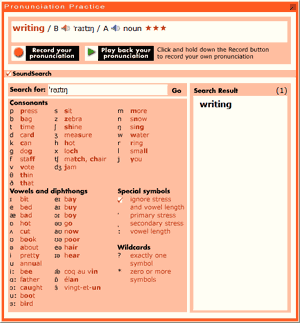|

FROM THE EDITOR
 In
this Issue In
this Issue
 Contributors Contributors
 Letters
to the Editor Letters
to the Editor
 Write
to Us Write
to Us
 Spread
the Word Spread
the Word
 Back
Issues Back
Issues
FEATURE
 My
Life-Long Love of the English My
Life-Long Love of the English
Language Business
Ken Wilson reflects on English
Language Teaching
COLUMNS
 Language
Interference Language
Interference
English Loan Words in Japanese
Read about the pitfalls of loan words and false friends in Japanese
 Focus
on Language Focus
on Language
Awareness
Introduction
Academic Writing:
Writing an Essay — How to begin
UK version ¦
US version
 New
word of the month New
word of the month
The Language of the Web
Read about the creation of new
words for the Internet
 Top
Tips for the CD-ROM Top
Tips for the CD-ROM
Find out how to practise
spelling with SoundSearch
 onestopenglish.com onestopenglish.com
|
 |
Top
Tips for the CD-ROM
by Jane
Bottomley
The SoundSearch tool of
the Macmillan English Dictionary CD-ROM allows you to search for
words by the way they sound. This tool is ideal for practising pronunciation
and raising students' awareness of the relationship between sound and
spelling in English.
In this issue of the magazine I will give you tips on
how students can use the SoundSearch to work on commonly misspelt
words, whilst at the same time practising using the phonemic symbols.
Dictation of commonly misspelt words
| Aim |
To raise awareness of common spelling mistakes and
practise using the phonemic symbols. |
| Activity |
Students try to spell words and transcribe them into
phonemic script. |
1. Choose about 10 words that cause problems for
the class. Common spelling mistakes can be gleaned from students' written
work or taken from the list below (based on my own students' errors, with
the problems in brackets):
| beautiful |
(vowel
combination; double l) |
| weather |
(wheather)
|
| absence |
(absense) |
| millennium |
(single
l or n) |
| definitely |
(definately)
|
| accommodation |
(single
c or m) |
| writing |
(writting
- confusion with
written) |
| vehicle |
(vehicule) |
| advertisement |
(advertisment) |
| successful |
(single
c or s;
double l) |
2. Dictate the words to the students. Where there
is ambiguity, give students further hints. For example, weather
(noun) as opposed to whether (conjunction): He walked for five
miles in bad weather.
3. Students compare spellings and try to correct each other's spelling
mistakes.
4. Students work in pairs to write phonemic transcriptions
using the SoundSearch key.
5. Students type their transcriptions into the
SoundSearch tool and check their spellings. Point out to them that
they need to include the stress mark(s) in their transcriptions.

6. In class, draw particular attention to:
- the use of the single l -ful suffix in adjectives
(eg beautiful, faithful, successful) and the double
l -fully suffix in adverbs (eg beatifully, faithfully,
successfully).
- the single t in the present participle writing,
compared to the double t in the past participle written.
|
Tip
As a follow-up activity, students
can open Pronunciation Practice and record and play back
their own pronunciation of the words.
|

|





